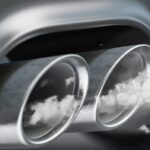
21 Aug Auto Exhaust System: So How Does It Work Anyway?
 Most motorists don’t spend a lot of time thinking about their vehicle’s exhaust system. Unless you’re into racing or own a high-maintenance, high-performance sports car, you probably only have the exhaust system serviced once a year or when a problem crops up. However, you don’t have to be a gear-head to learn a few facts about how your vehicle works. Plus, it’s beneficial to know when leaking fumes or a bad catalytic converter in your vehicle’s exhaust system requires auto repairs.
Most motorists don’t spend a lot of time thinking about their vehicle’s exhaust system. Unless you’re into racing or own a high-maintenance, high-performance sports car, you probably only have the exhaust system serviced once a year or when a problem crops up. However, you don’t have to be a gear-head to learn a few facts about how your vehicle works. Plus, it’s beneficial to know when leaking fumes or a bad catalytic converter in your vehicle’s exhaust system requires auto repairs.
How The Auto Exhaust System Work
The exhaust system is a marvel of engineering that serves several purposes. It routes the toxic gases the internal combustion engine creates through several components and out of the tailpipe. Along the way, it collects excess heat and purifies exhaust fumes while reducing the noise the whole process makes. It’s a pretty neat system that works consistently without a lot of maintenance requirements. Let’s take a look at some of the components more closely.
Exhaust Manifold
Starting at the beginning of the exhaust system is the exhaust manifold. The manifold gathers exhaust gases from the individual ports of the engine’s cylinder head. Then, it routes the fumes through the rest of the system. Different shaped engine designs determine if your vehicle has one or two manifolds.
Catalytic Converter
The catalytic converter acts as an emissions control device. It converts harmful exhaust gases into water, carbon dioxide, and nitrogen. Some vehicle’s catalytic converters are integrated into the exhaust manifold, while others attach to a vehicle’s exhaust pipe. Here’s a fun bit of trivia – some cars have only one catalytic converter, but others can have as many as four.
Oxygen Sensors
Oxygen sensors measure the amount of oxygen (or the concentration of combustibles) in the exhaust gases leaving the engine. Modern vehicles have both upstream and downstream oxygen sensors. Upstream oxygen sensor locations are before the catalytic converter, while downstream sensor locations are after the converter.
Muffler & Resonator
The muffler reduces or stifles the noise created by the engine. The exhaust system also has a resonator, which cancels out engine noises of specific frequencies.
Exhaust Pipes and Tailpipes
Exhaust pipes connect the numerous exhaust system components together. The pipes are often made from cast aluminum or stainless steel to help prevent rust and corrosion. The connections are sealed with rubber gaskets or metal flanges to prevent leaking fumes.
The tailpipe is the final part of the system puzzle. It directs the now-less-toxic exhaust fumes away from the vehicle and into the air.
Assorted Secondary Components
Throughout the exhaust system, various secondary components allow the primary parts to function correctly.
- Heat Shields – Heat shields are insulated pads or metal plates that help keep excess heat in the exhaust from melting or burning nearby systems.
- Gaskets, Flanges, and Seals – Rubber gaskets, metal flanges, and other seals between the exhaust pipes and other components create an airtight seal.
- Brackets and Mounting Hardware – The brackets, hangers, and other mounting hardware prevent the various exhaust components from rattling and shifting around while driving.
Exhaust System Issues & Causes
All vehicle parts wear down with use and time. Since most of the exhaust system is out of sight under the car, it can be easy to forget about it. However, exhaust fumes contain carbon monoxide, which is hazardous to your health and well-being. Therefore, take note of the following exhaust system issues and schedule a service with your local auto service center immediately if your vehicle shows these signs.
Leaking Fumes
Leaking fumes from your vehicle’s exhaust system is a serious health concern due to exposure to carbon monoxide. Additionally, leaking fumes in the system can create issues with the oxygen sensors. Malfunctioning oxygen sensors can lead to poor engine performance and a triggered Check Engine light. Schedule a diagnostic service immediately if you ever smell exhaust fumes inside the engine compartment or the interior cabin.
Clogged Exhaust
The exhaust system can get clogged from collision damage or engine (combustion) problems. A clogged exhaust often creates excessive back pressure, reducing engine performance. Your vehicle may exhibit slow or minimal acceleration, hard starts, and a triggered Check Engine light.
Loose Or Noisy Components
The heat shields, brackets, and other mounting hardware in your vehicle’s exhaust system can loosen due to collision damage or road debris. Loose components in the undercarriage create rattling, clanging, or scraping noises.
Damaged And Dirty Components
Exhaust system components can get damaged and dirty through normal wear, collision damage, and road debris. A trained technician can determine whether the parts require cleaning or replacement.
Exhaust System Auto Repairs in Plymouth Meeting, PA
If you want quality exhaust system maintenance and auto repairs in Plymouth Meeting, Plymouth Auto & Tire Center is here to help! Our highly-trained service technicians can perform a thorough vehicle inspection to detect leaking fumes and replace a faulty catalytic converter.
Schedule Exhaust System Auto Repairs
Contact us today at (610) 825-6558 or online to request an exhaust system appointment. You can count on our auto service center for an honest diagnosis and reliable auto repairs.

